Single-Carrier Rotation-Interleaved Space-Time Code for Frequency-Selective Fading Channels †
Abstract
1. Introduction
- A novel single-carrier-based full-rate space-time code construction scheme capable of attaining the maximum space-time-multipath diversity order is investigated. Without resorting to common OFDM-based design, this approach is low in PAPR. In principle, the proposed scheme is general and broadly applicable in the sense that, with proper rotation, it can be adopted for any number of transmit antennas or any type of modulation as well as flexible transmission rate, unlike the previous approaches which are fixated on certain transmission modes.
- In conjunction with the proposed space-time coding scheme, an efficient frequency-domain iterative receiver is developed. This receiver delivers good diversity performance while lowering the receiver complexity significantly. Thus, the proposed scheme may potentially employ powerful STC designed for flat fading channels as its constituent code. In particular, it is capable of outperforming some existing STTCs of comparable complexity which are designed for frequency-selective fading channels.
- Theoretical proofs, especially concerning the construction of our STC scheme and the desired rotations required to achieve full diversity gain, are provided. Simulation results are used to verify the performance gain of the proposed scheme.
2. System Model
3. Rotation-Interleaved Multi-Stream Space-Time Code
- The input data stream is demultiplexed into parallel sub-streams , .
- Each sub-stream is encoded by the same STC encoder. Denote the output codewords from the STC encoder corresponding to different sub-streams as , which are matrices, where .
- Each codeword is multiplied by a phasor to give .
- The codewords from the rotated sub-streams, enter a multiplexer, which does the following. Let , where denotes the ()-th column vector in , i.e., the code symbols transmitted at time t. By multiplexing these column vectors from different rotated STC sub-streams in a time-division fashion (see Figure 2), the super-codeword from the outputs of the multiplexer can now be expressed as
3.1. Symbol-Wise Random Phase Rotation
3.2. Symbol-Wise Deterministic Phase Rotation
- (a)
- BPSK codes
- (1)
- θ is chosen such that is an algebraic number with degree of or greater.
- (2)
- is an algebraic number (i.e., is transcendental).
- (b)
- QPSK/QAM codes
- (1)
- θ is chosen such that is an algebraic number with degree of or greater.
- (2)
- is an algebraic number (i.e., is transcendental).
3.3. Frequency-Domain Iterative Receiver
4. Simulation Results and Discussion
- A.
- Number of multipaths is two ()
- B.
- Number of multipaths is three ()
5. Conclusions
Author Contributions
Funding
Institutional Review Board Statement
Informed Consent Statement
Data Availability Statement
Conflicts of Interest
Appendix A. Lemmas for Propositions 2 and 3
Appendix B. Frequency Domain Iterative Receiver
References
- Xu, C.; Ishikawa, N.; Rajashekar, R.; Sugiura, S.; Maunder, R.G.; Wang, Z.; Yang, L.-L.; Hanzo, L. Sixty Years of Coherent Versus Non-Coherent Tradeoffs and the Road From 5G to Wireless Futures. IEEE Access 2019, 7, 178246–178299. [Google Scholar] [CrossRef]
- Tarokh, V.; Jafarkhani, H.; Calderbank, A. Space-time block codes from orthogonal designs. IEEE Trans. Inf. Theory 1999, 45, 1456–1467. [Google Scholar] [CrossRef]
- Gamal, H.E.; Harnmons, A.R. On the design and performance of algebraic space-time codes for BPSK and QPSK modulation. IEEE Trans. Commun. 2002, 50, 907–913. [Google Scholar] [CrossRef]
- De Almeida, A.L.; Antreich, F.; Haardt, M.; Cavalcante, C.C. Kronecker product-based space-time block codes. IEEE Wirel. Commun. Lett. 2022, 11, 386–390. [Google Scholar]
- Grabner, M.J.; Li, X.; Fu, S. An adaptive BLAST successive interference cancellation method for high data rate perfect space-time coded MIMO systems. IEEE Trans. Veh. Technol. 2020, 69, 15421553. [Google Scholar] [CrossRef]
- Feng, B.; Jiao, J.; Wang, S.; Wu, S.; Zhang, Q. Construction of polar codes concatenated to space-time block coding in MIMO system. In Proceedings of the 2016 IEEE 84th Vehicular Technology Conference (VTC-Fall), Montreal, QC, Canada, 18–21 September 2016. [Google Scholar]
- Tofigh, S.; Kermani, H.M.; Morsali, A. A new design criterion for linear receivers STBCs based on full-rank spaces. EEE Commun. Lett. 2014, 19, 207–210. [Google Scholar] [CrossRef]
- Harshan, J.; Viterbo, E. Integer space-time block codes for practical MIMO systems. IEEE Wirel. Commun. Lett. 2013, 2, 455–458. [Google Scholar] [CrossRef][Green Version]
- Mroueh, L.; Rouquette-Leveil, S.; Belfiore, J.C. Application of perfect space time codes: PEP bounds and some practical insights. IEEE Trans. Commun. 2012, 60, 747–755. [Google Scholar] [CrossRef]
- Xu, C.; Zhang, P.; Rajashekar, R.; Ishikawa, N.; Sugiura, S.; Wang, L.; Hanzo, L. Finite-Cardinality Single-RF Differential Space-Time Modulation for Improving the Diversity-Throughput Tradeoff. IEEE Trans. Commun. 2018, 67, 318–335. [Google Scholar] [CrossRef]
- Agrawal, D.; Tarokh, V.; Naguib, A.; Seshadri, N. Space-time coded OFDM for high data-rate wireless communication over wideband channels. In Proceedings of the 48th IEEE Vehicular Technology Conference (VTC ’98), Ottawa, ON, Canada, 21 May 1998; Volume 3, pp. 2232–2236. [Google Scholar]
- Liu, Z.; Xin, Y.; Giannakis, G. Space-time-frequency coded OFDM over frequency-selective fading channels. IEEE Trans. Signal Process. 2002, 50, 2465–2476. [Google Scholar]
- Yeh, H.-G. Design precoded space-time-frequency 4 × 1 and 4 × 2 OFDM architectures in frequency-selective fading channels. IEEE Syst. J. 2019, 14, 277–287. [Google Scholar] [CrossRef]
- Ma, X.; Giannakis, G.B. Space-time-multipath coding using digital phase sweeping. In Proceedings of the Global Telecommunications Conference (GLOBECOM ’02), Taipei, Taiwan, 17–21 November 2002; Volume 1, pp. 384–388. [Google Scholar]
- Mohammadian, Z.; Shahabinejad, M.; Talebi, S. New Full-Diversity Space-Frequency Block Codes Based on the OSTBCs. IEEE Commun. Lett. 2012, 16, 1620–1623. [Google Scholar] [CrossRef]
- Flores, J.; Sanchez, J.; Jafarkhani, H. Quasi-orthogonal space-time-frequency trellis codes for two transmit antennas. IEEE Trans. Wirel. Commun. 2010, 9, 2125–2129. [Google Scholar] [CrossRef]
- Gore, D.; Sandhu, S.; Paulraj, A. Delay diversity codes for frequency selective channels. In Proceedings of the 2002 IEEE International Conference on Communications, New York, NY, USA, 28 April–2 May 2002; Volume 3, pp. 1949–1953. [Google Scholar]
- Liu, Y.; Fitz, M.P.; Takeshita, O.Y. Space-time codes performance criteria and design for frequency selective fading channels. In Proceedings of the IEEE International Conference on Communications (ICC 2001), Helsinki, Finland, 11–14 June 2001; Volume 9, pp. 2800–2804. [Google Scholar]
- Al-Dhahir, N. Single-carrier frequency-domain equalization for space-time block-coded transmissions over frequency-selective fading channels. IEEE Commun. Lett. 2001, 5, 304–306. [Google Scholar] [CrossRef]
- Zhou, S.; Giannakis, G.B. Single-carrier space-time block-coded transmissions over frequency-selective fading channels. IEEE Trans. Inform. Theory 2003, 49, 164–179. [Google Scholar] [CrossRef]
- Gamal, H.E.; Hammons, A.R.H., Jr.; Liu, Y.; Fitz, M.P.; Takeshita, O.Y. On the design of space-time and space-frequency codes for MIMO frequency-selective fading channels. IEEE Trans. Inform. Theory 2003, 49, 2277–2292. [Google Scholar] [CrossRef]
- Ciochina, C.; Castelain, D.; Mottier, D.; Sari, H. A Novel Quasi-Orthogonal Space-Frequency Block Code for Single-Carrier FDMA. In Proceedings of the VTC Spring 2008—IEEE Vehicular Technology Conference, Singapore, 11–14 May 2008; pp. 1137–1141. [Google Scholar]
- Qin, M.; Blum, R.S. Properties of space-time codes for frequency-selective channels. IEEE Trans. Signal Process. 2004, 52, 694–702. [Google Scholar] [CrossRef]
- Kansanen, K.; Matsumoto, T. An analytical method for MMSE MIMO turbo equalizer EXIT chart computation. IEEE Trans. Wirel. Commun. 2007, 6, 59–63. [Google Scholar] [CrossRef]
- Ng, B.K.; Lam, C.T. Single-carrier time-interleaved space-time code for frequency-selective fading channels. In Proceedings of the 2014 IEEE 8th Sensor Array and Multichannel Signal Processing Workshop (SAM), A Coruna, Spain, 22–25 June 2014. [Google Scholar]
- Gamal, H.E.; Damen, M.O. Universal space-time coding. IEEE Trans. Inf. Theory 2003, 49, 1097–1118. [Google Scholar] [CrossRef]
- Giraud, X.; Boutillon, E.; Belfiore, J.-C. Algebraic tools to build modulation schemes for fading channels. IEEE Trans. Inform. Theory 1997, 43, 938–952. [Google Scholar] [CrossRef]
- Damen, M.O. Joint Coding/Decoding in a Multiple Access System, Application to Mobile Communications. Ph.D. Thesis, ENST, Paris, France, 1999. [Google Scholar]
- Gromann, M. Transmission Strategies for Broadband Systems with MMSE Turbo Equalization. Ph.D. Thesis, Ilmenau University of Technology, Ilmenau, Germany, 2012. [Google Scholar]
- Trofimov, A.; Johansson, T. A memory-efficient optimal APP symbol-decoding algorithm for linear block codes. IEEE Trans. Commun. 2004, 52, 1429–1434. [Google Scholar] [CrossRef]
- Shrestha, R.; Paily, R.P. High-Throughput Turbo Decoder With Parallel Architecture for LTE Wireless Communication Standards. IEEE Trans. Circuits Syst. Regul. Pap. 2014, 61, 2699–2710. [Google Scholar] [CrossRef]
- Su, W.; Xia, X.G. Signal constellations for quasi-orthogonal space-time block codes with full diversity. IEEE Trans. Inf. Theory 2004, 50, 2331–2347. [Google Scholar]
- Grimm, J.; Fitz, M.P.; Krogmeier, J.V. Further results on space-time coding for Rayleigh fadin. In Proceedings of the Annual Allerton Conference on Communication Control and Computing, Monticello, IL, USA, 23–26 September 1998; pp. 391–400. [Google Scholar]
- Yan, Q.; Blum, R.S. Improved space-time convolutional codes for quasi-static slow fading channels. IEEE Trans. Wirel. Commun. 2002, 1, 563–571. [Google Scholar]
- Hammons, A.R.; Gamal, H.E. On the theory of space-time codes for PSK modulation. IEEE Trans. Inf. Theory 2000, 46, 524–542. [Google Scholar] [CrossRef]
- Hong, Y.; i Fabregas, A.G. New space-time trellis codes for two-antenna quasi-static channels. IEEE Trans. Veh. Technol. 2007, 56, 3581–3587. [Google Scholar] [CrossRef]
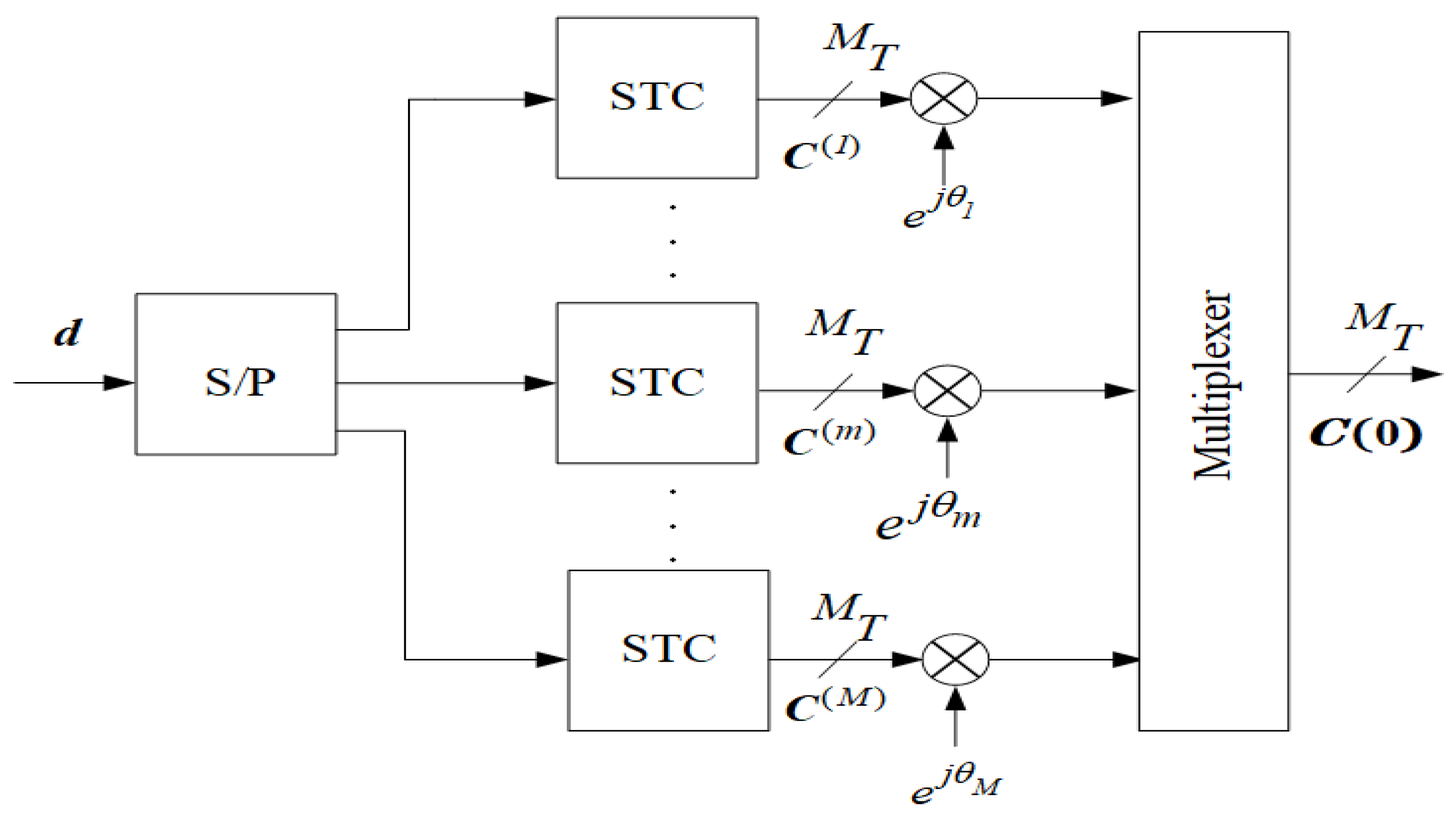
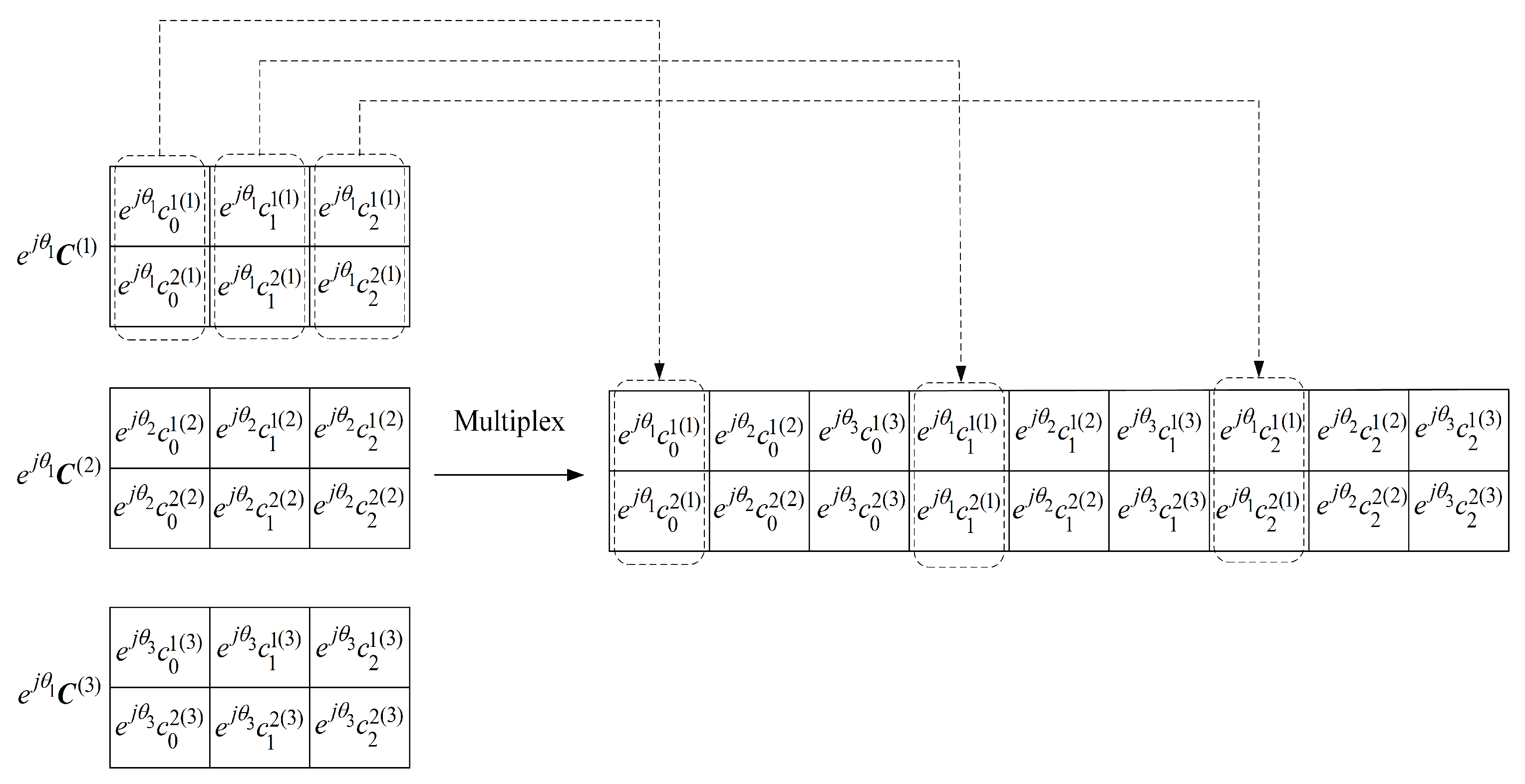
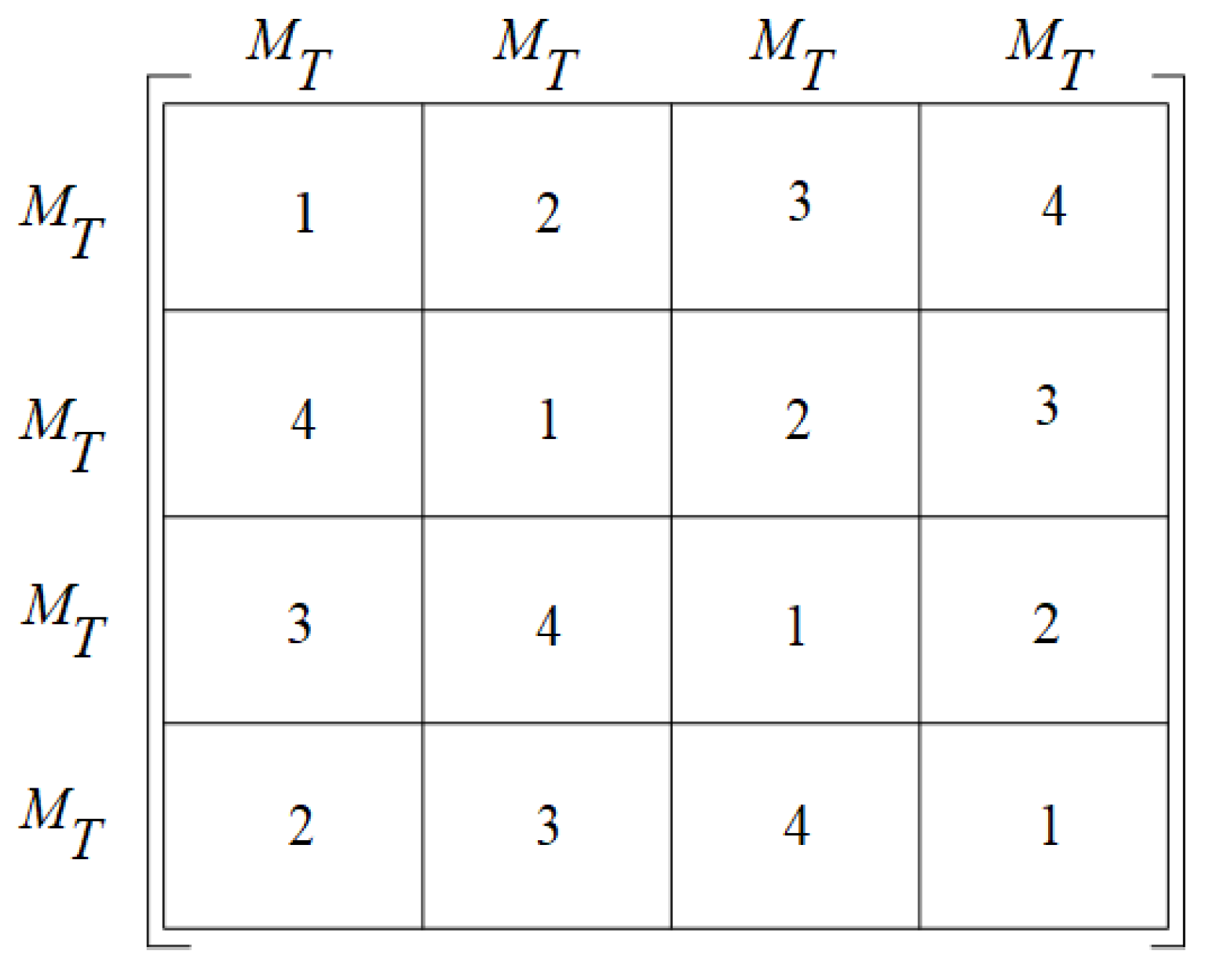
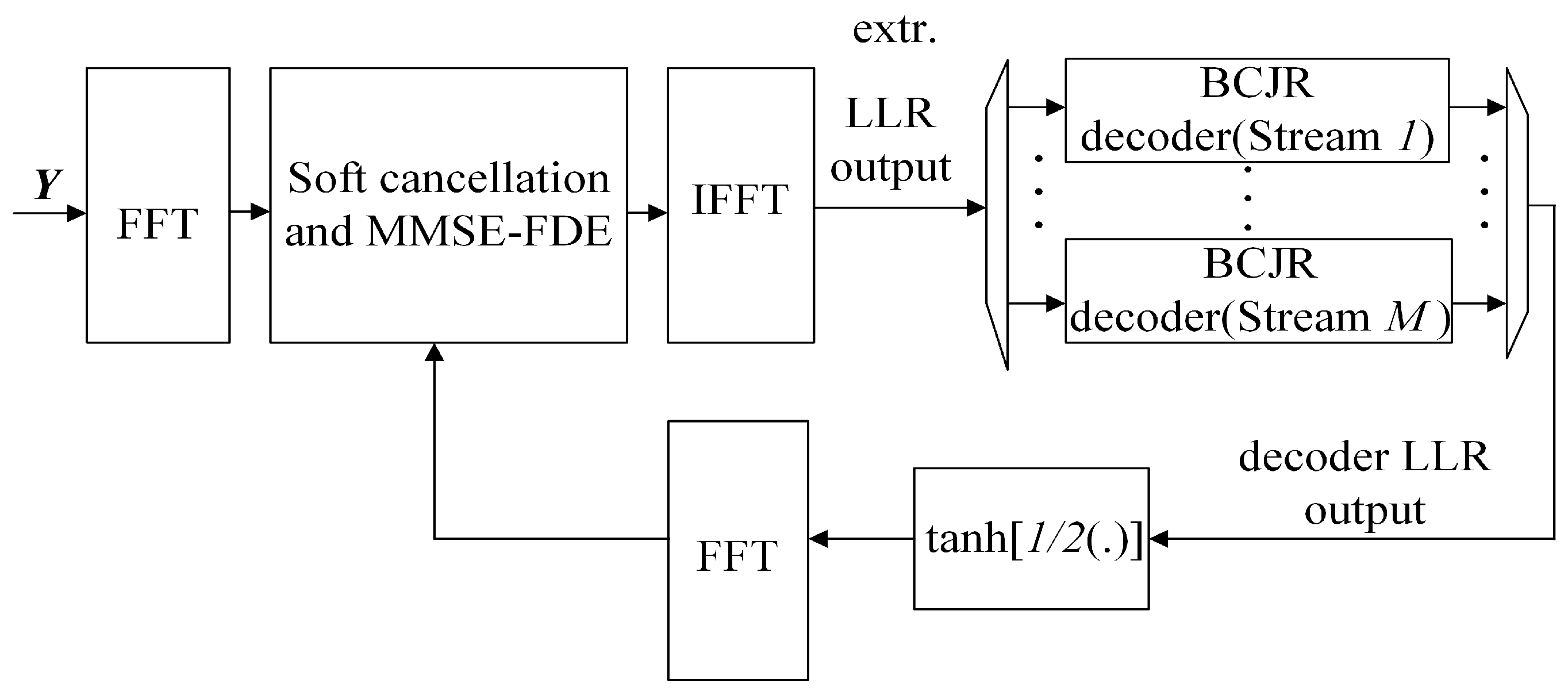


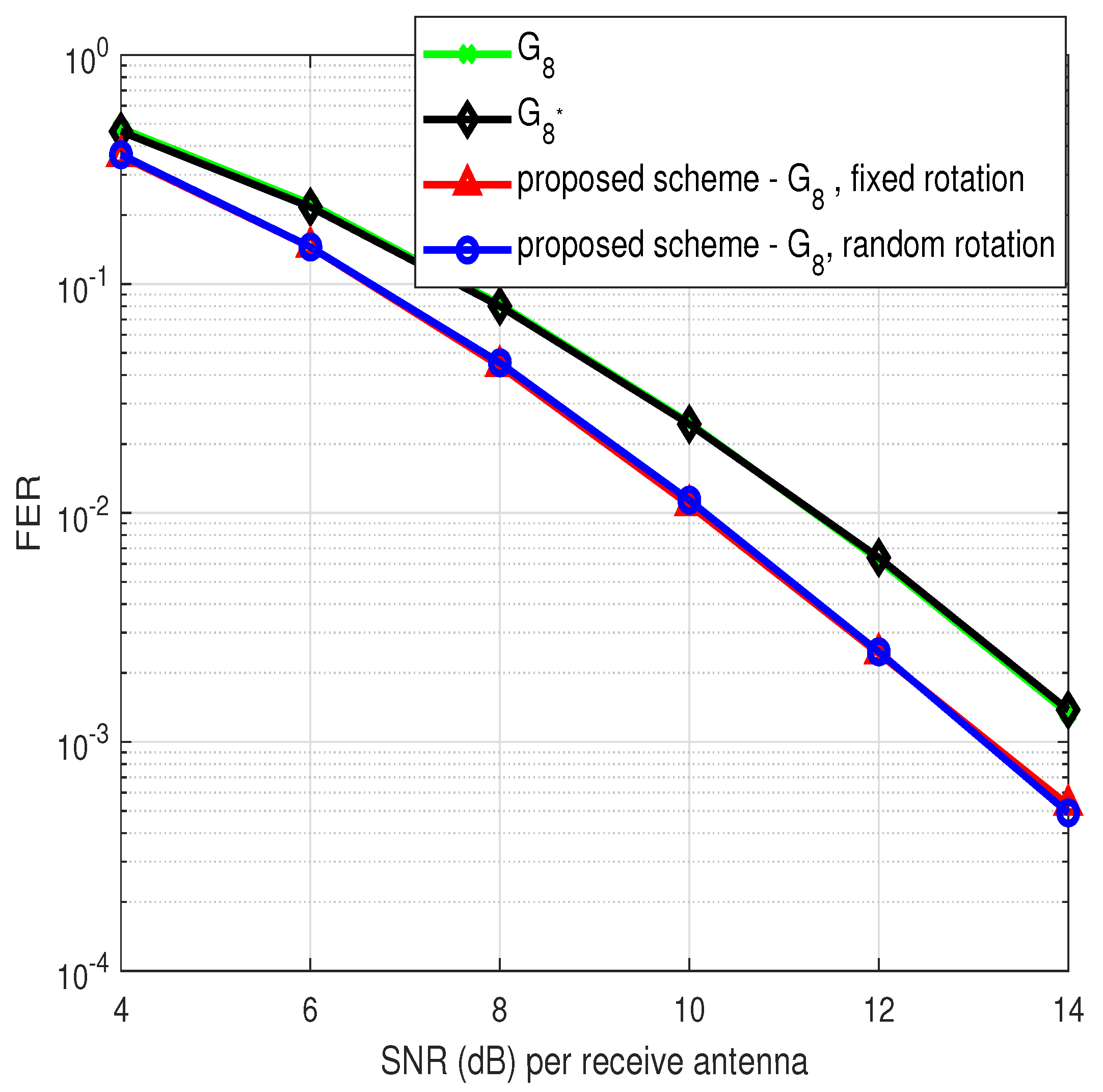
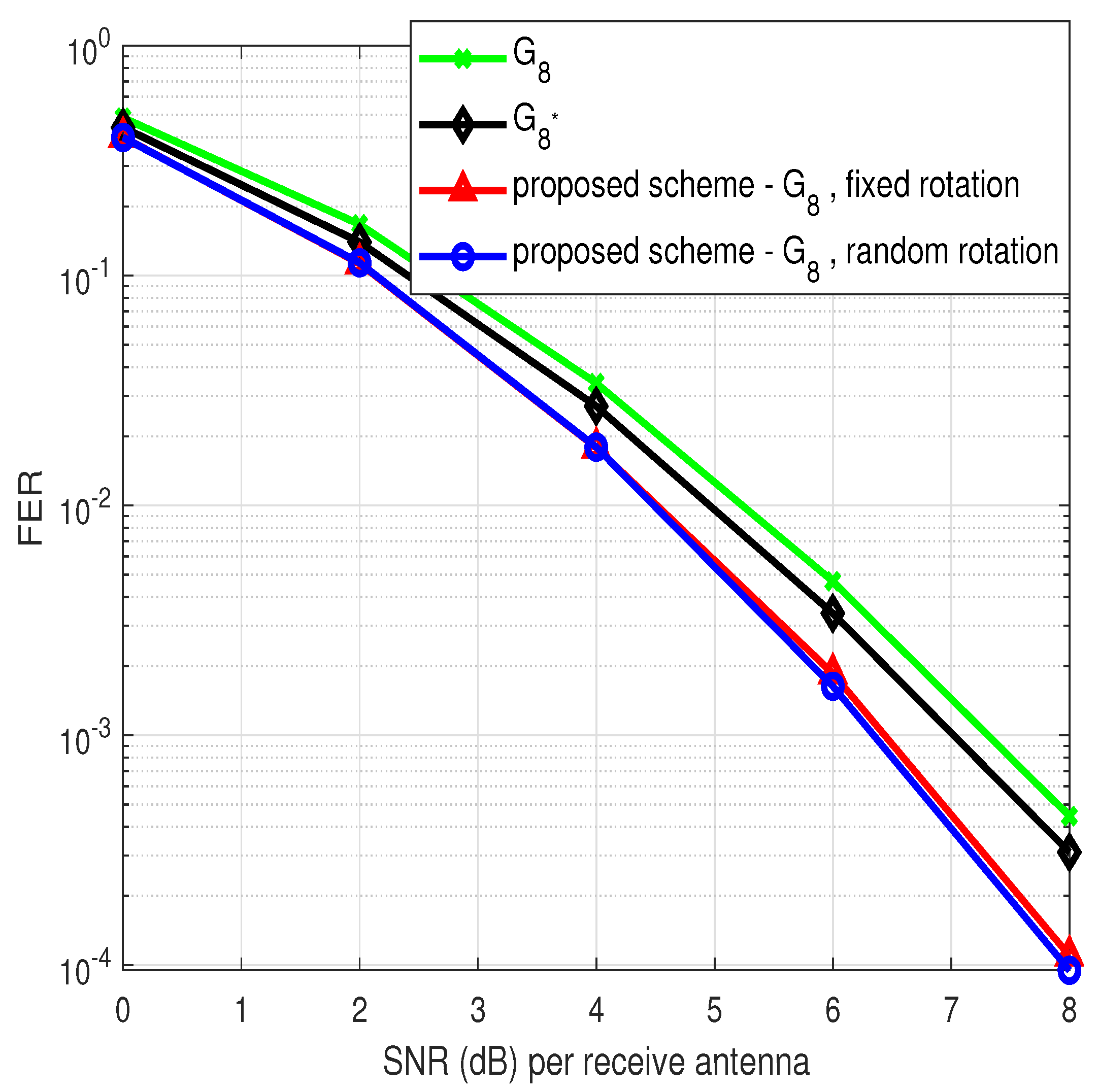
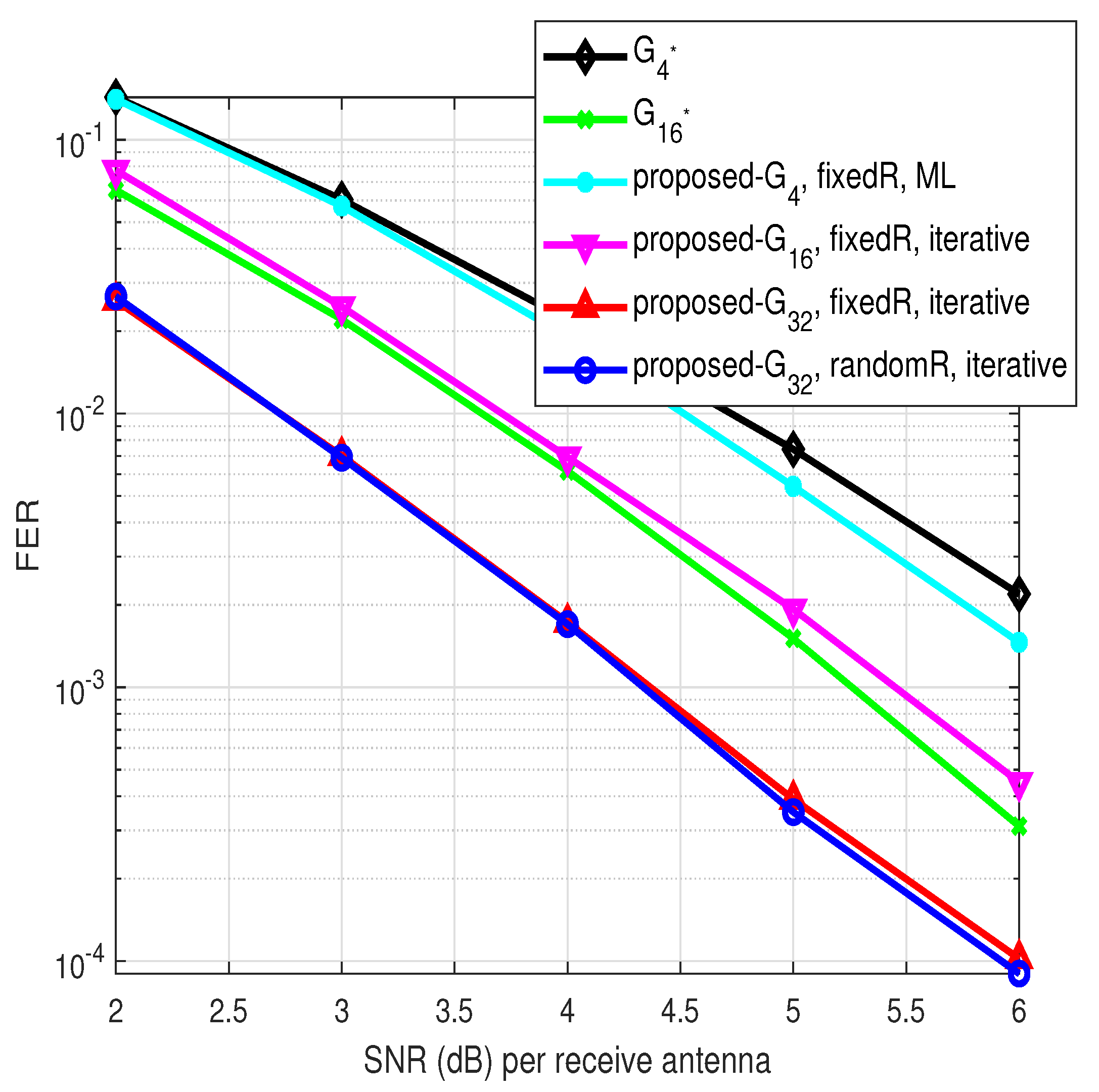

| Schemes | [17] | [19] | [20] | [21] | [22] | [23] |
| Modulation | Any | Any | Any | Specific | Any | Specific |
| No. of Tx Antennas | Any | Any | Any | Specific | Fixed | Specific |
| Full-Rate | × | × | × | ✓ | ✓ | ✓ |
| Full space-time-multipath diversity | ✓ | ✓ | ✓ | ✓ | ✓ | ✓ |
| Numerical Search/Verification | × | × | × | ✓ | × | ✓ |
Publisher’s Note: MDPI stays neutral with regard to jurisdictional claims in published maps and institutional affiliations. |
© 2022 by the authors. Licensee MDPI, Basel, Switzerland. This article is an open access article distributed under the terms and conditions of the Creative Commons Attribution (CC BY) license (https://creativecommons.org/licenses/by/4.0/).
Share and Cite
Ng, B.K.; Lam, C.-T. Single-Carrier Rotation-Interleaved Space-Time Code for Frequency-Selective Fading Channels. Appl. Sci. 2022, 12, 12803. https://doi.org/10.3390/app122412803
Ng BK, Lam C-T. Single-Carrier Rotation-Interleaved Space-Time Code for Frequency-Selective Fading Channels. Applied Sciences. 2022; 12(24):12803. https://doi.org/10.3390/app122412803
Chicago/Turabian StyleNg, Benjamin K., and Chan-Tong Lam. 2022. "Single-Carrier Rotation-Interleaved Space-Time Code for Frequency-Selective Fading Channels" Applied Sciences 12, no. 24: 12803. https://doi.org/10.3390/app122412803
APA StyleNg, B. K., & Lam, C.-T. (2022). Single-Carrier Rotation-Interleaved Space-Time Code for Frequency-Selective Fading Channels. Applied Sciences, 12(24), 12803. https://doi.org/10.3390/app122412803







